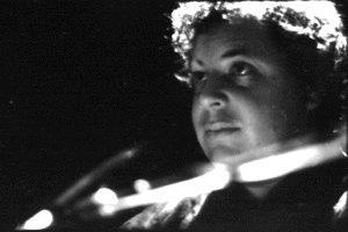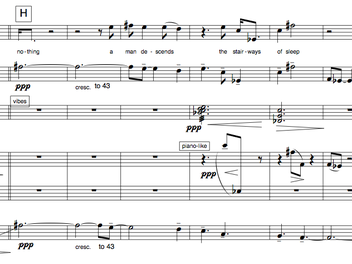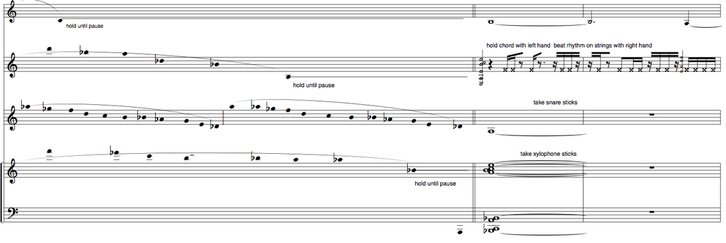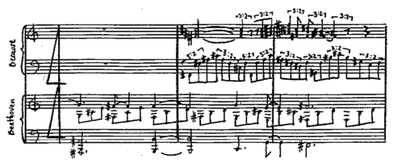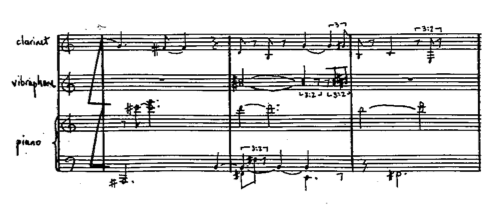1990
19 All about Eve [1990] Clarinet and walkman with wearable mobile speakers 5m
|
18 Leo Szilard [1990] s. sax, t. sax, b.sax, pno, mba, vcl and bass guitar 6m
Leo Szilard was a Hungarian Physicist who, as a result of his work in physics in Germany in the early thirties, fled the changing political climate to persuade non-facist powers to begin development of an 'Atomic' bomb. His tenacious efforts finally succeeded, through the help of Albert Einstein, in persuading Roosevelt to initiate the 'Manhattan Project'. In the closing weeks of the war in Europe, Szilard attempted to persuade the government of the United States that a 'Super Bomb' was no longer necessary and along with a group of Physicists based in Chicago pointed out many of the long term effects that this escalation in weapons technology would have. Unsuccessful in dampening the new enthusiasm for the Atomic Bomb, Szilard set up the first anti-nuclear lobby group: the Council for a Livable World. |
17 Ed Teller Remembers [1990] Perc., Reciter and Assistant 11m
|
Edward Teller (b. 1908) was the nuclear physicist who managed the development of the Hydrogen Bomb [also nicknamed the ‘dirty’ bomb as it produced far more highly radio-active material than any other device]. Teller refered to this weapon as ‘the Super’. He was also instrumental in the development of the ‘clean’ bomb or neutron bomb that destroys only organic material and leaves buildings and other structure relatively entact. He also gained a place in history by apparently being the person upon whom Stanley Kubrick based the character 'Dr. Strangelove' from the landmark Anti-war satire of the same name. In recent years he become a high-profile advocate of the Strategic Defense Initiave or ‘star wars’ project. There are some who think he has much to remember. |
|
Ed Teller Remembers is not a portrait piece or a direct criticism of Teller who has been described as "one of the most thoughtful statesmen of science, " and who clearly thought of himself as a patriot. It is more a symbollic representation of the way that our society has tended to escalate our isolation with concepts such as ‘MAD’ [Mutually Assured Destruction]. It is also explores the difficulty we face as individuals in ingesting the detail of very large-scaleproblems and remaining focussed on their possible solutions.
original draft for the work
|
|
16 vo [1990] soprano, s. sax, perc. kbd and vcl 12m
The text of vo, a sort of post-apocalyptic dream, is a collage of words that I assembled from a large body of poems by Andre Breton and Phillipe Soupault collectively called The Magnetic Fields. The collection is regarded as one of the first examples of Surrealist ‘automatic writing’. Written in 1919, the text is often full of images that conjure a world disturbly close to that predicted post-nuclear exchange. vo explores these images that have become deeply rooted in contemporary consciousness. vo was first presented in the anti-nuclear concert n • blackflowers by a l e a new music ensemble and was intended to be one of a set of pieces dealing with this issue: the others were the ensemble piece Leo Szilard and the percussion/theatre work Ed Teller Remembers. |
1989
15 A-Synchronous Au Privave [1989] a. sax., vln, acc., bass and drums 7m
|
Once upon a time ross bolleter was travelling in his car towards a gig...suddenly a tune leapt into his head Charlie Parker's au privave...soon he arrived at the club opened the door of his car and ...can it be...in the same key...well every action has its equal and opposite reaction so here it is just in time
a-synchronous au privave, a 'sort of free entropic incantation', was intended to be an antidote to ruined accordion and piano improvisor Ross Boletter's synchronous event of finding that the tune in his head as he arrived late for a gig was being simultaneously played by his more punctual colleagues. In my opinion such events badly upset the natural chaotic balance of the universe so it became necessary to create this piece to even things up....The 'head' and solos are cut-ups of Charlie Parker's original and there is an obbligato violin part that, rather like the 'druids who know see and hear nothing' in Ives' The Unanswered Question remains aloof throughout the performance. |
14 Learning to Fly (with Jonathan Mustard )(music for Meredith Russel's and John McLaughlin's Dance/Sculpture Event) [1989] Cello, Flute/Saxophone, Clarinet/Saxophone,Guitar/Percussion, Percussion 5 players 93m
13 coffee [1989] reciter and dancer 8m
12 stairways of sleep [1989] cl., e. guitar, perc. and pno 8m
The work’s title is drawn from the proto-surrealist poetry of André Breton and Phillipe Soupault’s The Magnetic Fields [1919]. (A collage of the same poems, was also the source of the text for my song cycle vo [1990]). In creative work, one is faced with a multitude of possible pathways. The phrase ‘stairways of sleep’ suggested to me ascending [or descending] pathways navigable only in a subconscious state. In this sense stairways structure takes the listener on an associative journey through related musical materials.
stairways of sleep occupies a singular place in my output: prior works almost exclusively involved quotation of others’ music (Twilight’s Last Gleamings [1986]- patriotic American Songs, Savoy Trifle [1988] - Berg/Parker, Blackpool Tower [1989] Beethoven/Lennon.) stairways marks the beginning of a period in which I began working with original material using the techniques I had developed for the collage works. This material became the basis for the musical language of many works to follow such as Leo Szilard [1990], phase matrix [1993] and horology [1999]. It also contains several sonic archetypes that have re-emerged in my music from time to time, most notably the ethereal descending passage at the heart of the work.
The work’s title is drawn from the proto-surrealist poetry of André Breton and Phillipe Soupault’s The Magnetic Fields [1919]. (A collage of the same poems, was also the source of the text for my song cycle vo [1990]). In creative work, one is faced with a multitude of possible pathways. The phrase ‘stairways of sleep’ suggested to me ascending [or descending] pathways navigable only in a subconscious state. In this sense stairways structure takes the listener on an associative journey through related musical materials.
stairways of sleep occupies a singular place in my output: prior works almost exclusively involved quotation of others’ music (Twilight’s Last Gleamings [1986]- patriotic American Songs, Savoy Trifle [1988] - Berg/Parker, Blackpool Tower [1989] Beethoven/Lennon.) stairways marks the beginning of a period in which I began working with original material using the techniques I had developed for the collage works. This material became the basis for the musical language of many works to follow such as Leo Szilard [1990], phase matrix [1993] and horology [1999]. It also contains several sonic archetypes that have re-emerged in my music from time to time, most notably the ethereal descending passage at the heart of the work.
11 Double Concerto for Knitters and Ensemble [1989] Knitter /1 Knitter reciter (amplified ), 4 Saxophones, bass and keyboard or similar combination 6m
The Double Concerto for Knitters and Ensemble, began with one of my then sister-in-law Angela Rossen's summer obsession with knitting. Being entranced by the beautiful clack of her knitting needles , she emplored me to write a piece for them. While sceptically perusing her pattern book, I came upon the 'Fair Isle' knitting pattern. Its grid of arpeggio-like zig-zags immediately suggested the possibility of a peculiar kind of minimalist texture. In the first performance Angela and her friend Johanna Benchoff performed on close-miced knitting needles while Johanna recited the 'Alternating Peanut Stitch' [the most dramatic knitting text available] The original title also from the book in question was Double Knitting Concerto: Little Trees, the Palms, Scattered Leaves (Tunisian Knitting).
The Double Concerto for Knitters and Ensemble, began with one of my then sister-in-law Angela Rossen's summer obsession with knitting. Being entranced by the beautiful clack of her knitting needles , she emplored me to write a piece for them. While sceptically perusing her pattern book, I came upon the 'Fair Isle' knitting pattern. Its grid of arpeggio-like zig-zags immediately suggested the possibility of a peculiar kind of minimalist texture. In the first performance Angela and her friend Johanna Benchoff performed on close-miced knitting needles while Johanna recited the 'Alternating Peanut Stitch' [the most dramatic knitting text available] The original title also from the book in question was Double Knitting Concerto: Little Trees, the Palms, Scattered Leaves (Tunisian Knitting).
10 Ancient Streams Deep and Beautiful (seen through new eyes) [1989] solo accordionist 12m
Ancient Streams... for Piano Accordionist was written for Ross Bolleter to play at the first [and only] performance of ZuT: a trio consisting of Ross, Jonathan Mustard and myself.
This work was in part a playful homage to Ross's notoriously inspired improvisational skills and his charming stage presence, characteristics that I hoped would range freely within what I thought was a suitably labyrinthine structure. [For example at one point he is instructed to play a perhaps non-existent tango while projecting a range of emotional states ranging from 'neurotic infatuation' to 'deeply ingrained reserved hatred'.]
Ancient Streams... was written in the 'birthhouse' of Hungarian Physicist Leo Szilard [later the subject of another of my pieces], which was at that time used as student accommodation for the Franz Liszt Academy in Budapest. It includes a 'cutup' text loosely concerning the act of musical composition, excised from the writings of Larry Polanski, Anton Webern and Luciano Berio amongst others. The text:
Ancient Streams... for Piano Accordionist was written for Ross Bolleter to play at the first [and only] performance of ZuT: a trio consisting of Ross, Jonathan Mustard and myself.
This work was in part a playful homage to Ross's notoriously inspired improvisational skills and his charming stage presence, characteristics that I hoped would range freely within what I thought was a suitably labyrinthine structure. [For example at one point he is instructed to play a perhaps non-existent tango while projecting a range of emotional states ranging from 'neurotic infatuation' to 'deeply ingrained reserved hatred'.]
Ancient Streams... was written in the 'birthhouse' of Hungarian Physicist Leo Szilard [later the subject of another of my pieces], which was at that time used as student accommodation for the Franz Liszt Academy in Budapest. It includes a 'cutup' text loosely concerning the act of musical composition, excised from the writings of Larry Polanski, Anton Webern and Luciano Berio amongst others. The text:
|
Ancient Streams Deep and Beautiful
[those who have ears let them hear!] I think we go about it this way I begin by outlining my plan I walk around in it make my first tentative steps and the secrets of the language are wrestled to the surface like slowly drawing a needle through a thick leather sack [and the secrets are wrestled like slowly drawing] anagramma a tale: those that master these storms must rest at the last wave a tale: her straw hat moves at last! a tale all to see the vast hole where heroes rot |
mors est
that which engenders the decay of information that which retards the decay of information la dolce vita [est] originally it was to last 3 months, but the degree of polarization which followed, became more of a personal laboratory, thus a step away from the text excursions into sentiments or ideas of order... this of course necessitates a rather greater procedure of paraphrasing In this view then, all those interpenetrations which at first glance appeared to be hellish, history for example are to be espoused |
9 Blackpool Tower: Elegy for John Lennon [1989] cl., guitar, vibes and pno 10m
|
Blackpool Tower: Elegy for John Lennon uses direct quotation of two pieces, the first movement of Beethoven's Moonlight Sonata, and The Beatles' Because from Abbey Road. Because was inspired by Lennon hearing Yoko Ono play the Moonlight Sonata. Both pieces share a number of characteristics (C Sharp minor, the arpeggio figurations, chord progressions, etc). The intention was to create an environment where the musical images would flow freely, subconsciously, against a harmonic background where the domination of the texture by one would always be undermined by the emergence of the other. The Moonlight Sonata and Because are theoretically 'playing' together throughout the entire length of the piece. However, for most of Blackpool Tower they are shrouded in various ways, only drawing into focus together in the five central bars.
|
|
At the opening of the work, both pieces are reduced to their constituent twelve pitches, dispersed and unpulsed. Gradually the pitches are assembled using a method of filtering, to allow the notes to settle into a recognisable framework. In order to keep the two works running together proportionally, a mock up of the original was made where both pieces were scored with their respective rhythmic notations reversed - ie the Beethoven, originally scored in quaver triplets is notated in duplet quavers and Because, in duplet quavers is scored in triplets as seen in the figure to the left.
|
|
The final note positions were then 'filtered' from the mock up by using first only pitches that had not appeared before, then only the first appearance of a pitch within 12 quavers, then 11 quavers, 10 quavers and so on until both pieces had entirely surfaced. There was of course also subjective tampering with the portions that were allowed to rise out from this gradually coalescing background. The five bars in which the two works simultaneously draw into focus are the passages in each work that are the most similar musically. For the first time in the work they appear 'quaver equals quaver'. The Beethoven scored in quaver triplets and Because in quaver duplets are quickly pulled out of synchronization - out of focus again.
|


